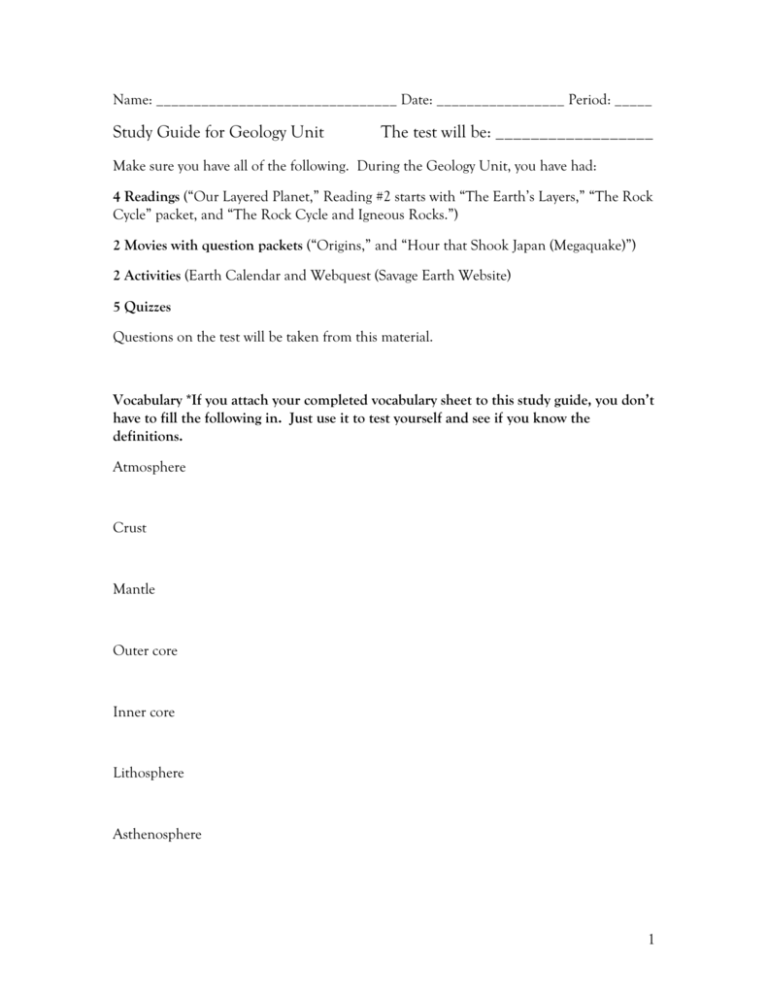Study Guide
advertisement

Name: ________________________________ Date: _________________ Period: _____ Study Guide for Geology Unit The test will be: __________________ Make sure you have all of the following. During the Geology Unit, you have had: 4 Readings (“Our Layered Planet,” Reading #2 starts with “The Earth’s Layers,” “The Rock Cycle” packet, and “The Rock Cycle and Igneous Rocks.”) 2 Movies with question packets (“Origins,” and “Hour that Shook Japan (Megaquake)”) 2 Activities (Earth Calendar and Webquest (Savage Earth Website) 5 Quizzes Questions on the test will be taken from this material. Vocabulary *If you attach your completed vocabulary sheet to this study guide, you don’t have to fill the following in. Just use it to test yourself and see if you know the definitions. Atmosphere Crust Mantle Outer core Inner core Lithosphere Asthenosphere 1 Convergent boundary Divergent boundary Transform fault boundary Mid ocean ridge Subduction zone Deep Sea trench Continental Drift Pangaea Sea Floor Spreading Earth’s Magnetic Field (Magnetosphere) Normal Polarity Reversed Polarity Curie Point 2 Paleomagnetism Plate Tectonics Amplitude Focus Epicenter Seismic Waves S-waves P-waves Surface Waves Fault Magnitude Richter Scale Intensity 3 Modified Mercalli Intensity Scale Chemical weathering Physical weathering Erosion Lithifaction Mineral Rock Igneous Metamorphic Sedimentary Intrusive Extrusive 4 Questions 1. Simply, how was Earth born? About how old is the Earth? 2. What was the “iron catastrophe?” How is that relevant to our study of geology? 3. Draw all layers of the Earth and LABEL them. Then, after each label write (S) if the layer is solid, (M) if it is molten, and (SM) if it is semi-molten. 4. What layers comprise the lithosphere? Asthenosphere? 5 5. List the three types of plate boundaries. Tell me what you know about each type. 6. Explain how the North America can be moving away from Western Europe. (Use the vocabulary words lithosphere, Asthenosphere, plate tectonics, and one of the 3 plate boundary types). 7. What two plate boundaries may cause earthquakes? 8. What two scales are used to measure earthquakes? How do the two differ in what they measure? What do the scales go from and to? 9. How much more shaking occurs in an earthquake that measures 6.0 on the Richter Scale than an earthquake that measures 5.0 on the Richter Scale? 10. What is Pangaea? How does the study of rocks support the theory of Pangaea? Does the theory of Pangaea support the theory of plate tectonics? How? 6 11. Tell me everything you can about the earthquake that hit Honshu, Japan on March11, 2011. Tell me how it happened, what the effects were, and what this may tell us about the western US coastline. 12. How does Earth’s magnetic field support life on Earth? 13. What is the “rock cycle?” 14. What is the difference between a rock and a mineral? 7 15. Name the three different types of rocks. Explain how each forms. 16. What do color and crystal size tell you about a rock? 17. What is an intrusive igneous rock? What is an extrusive igneous rock? 18. What is “weathering?” Give an example of chemical weathering and an example of physical weathering. 19. What is erosion? What 4 things cause erosion? 8 20. Give three examples of each: igneous rock, sedimentary rock, and metamorphic rock. 21. What type of rock contains fossils? 22. Molten rock above ground is called ______________________ and molten rock below ground is called _________________________. 23. “Acidic” rocks have more ____________________ than “less acidic” rocks. (Why did I use quotation marks here?) 24. What are the two types of igneous rock? Three types of sedimentary rock? What are the two types of metamorphic rock? 9







